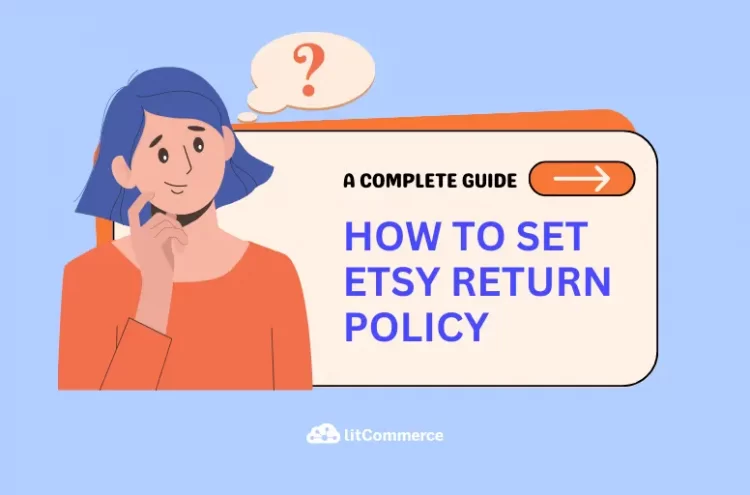As an Etsy seller, it’s important to have a clear and concise return policy that aligns with Etsy’s guidelines. By doing so, you’ll not only protect yourself from potential disputes with buyers but also build trust with your customers. However, creating an Etsy return policy that’s both fair and easy to understand can be a challenging task, especially if you’re new to selling on Etsy.
That’s why in this article, we’ll be covering:
- What is Etsy return policy?
- How does Return on Etsy work?
- How to set up an Etsy return policy?
- What to consider before setting Etsy return policy?
Let’s dive in!
What is Etsy Return Policy?
Etsy is an online marketplace that allows individuals and small businesses to sell handmade, vintage, and unique items to customers all over the world.
You may ask, “Is selling on Etsy worth it?” With millions of active buyers, Etsy is among best selling platforms for anyone looking to start their own online business.
When it comes to selling on Etsy, having a clear and fair return policy is essential for both sellers and buyers. Etsy return policy allows customers to return items for a refund or exchange within a specific timeframe, as long as the item is not custom-made or personalized. By setting up an Etsy returns policy, sellers can provide their customers with a sense of security, which can lead to increased sales and customer loyalty.
In addition to providing peace of mind to customers, a well-crafted Etsy return policy can also benefit Etsy sellers in other ways. For example, it can help prevent disputes or negative reviews while keeping the costs running low on refunds. This is crucial for Etsy starters, as you need to fully understand “How much does it cost to start an Etsy shop?” to factor in all the costs and make a profit.
Therefore, if you plan to start selling on Etsy, you should take the time to create a clear and fair return policy that aligns with Etsy’s guidelines. By doing so, you’ll be able to build trust with your customers and set your shop up for success.
As an Etsy seller, you might also want to read:
How Does Return on Etsy Work?
Etsy’s return policy allows customers to request refunds or exchanges for items they have purchased, as long as the seller’s shop policies allow for it. As “Can you return on Etsy?” is always on the buyers’ asking list, it’s crucial that you have a policy in place for your buyers.
Let’s take a closer look at how these Etsy shop policies might work for you!
1. Etsy refunds
When selling on one of the top marketplaces like Etsy, understanding how refunds work is crucial for sellers to fulfill their responsibilities and provide excellent customer service. The marketplace allows you to create and enforce your own Etsy refund policy, so it’s essential to set clear guidelines for refunds, exchanges, and returns.
Buyers can request a refund through Etsy’s messaging system if you have a return policy in place. You have a set amount of time to respond and provide instructions on how to proceed. If you approve the refund, the buyer will receive a shipping label to send the item back. Once you receive the item, you’ll issue a refund to the buyer in the original payment method used. Shipping costs are typically not refundable unless the item is not as described.
If you don’t have a return policy, buyers can still contact you directly for a refund. If you don’t respond or refuse the refund, the buyer can escalate the issue through Etsy’s resolution center.
In addition, if you sell to EU buyers, you must comply with the EU Directive on Consumer Rights by providing a refund policy. In case of disputes, Etsy’s case system is recommended to resolve issues. You can create a refund policy template to clarify your policy for buyers.
2. Etsy exchanges
If you’re a seller outside of the EU, you can choose to offer exchanges or not and must communicate your policy to buyers. If a buyer contacts you directly to request an exchange, it’s up to you to decide whether or not to fulfill the request.
It’s important to note that some sellers can choose only to offer exchanges for certain items or in certain circumstances. For example, you may only offer exchanges for items that are damaged or defective upon arrival or for items that are the wrong size or color. In addition, some sellers may require that the original item be returned before the replacement is sent out. This is to ensure that the buyer has indeed returned the original item before sending out the replacement.
If you do agree to an exchange, make sure to communicate the details clearly with the buyer and obtain proof of shipping for the replacement item. It’s important to note that Etsy’s case system only handles refunds, not exchanges.
How to Set Up Etsy Return Policy?
Now that you understand the importance of having a clear and fair Etsy return policy, it’s time to learn how to set one up. In this section, we’ll walk you through the process of creating an Etsy return policy that aligns with Etsy’s guidelines and meets the needs of your customers.
1. How to write a return policy on Etsy?
With Etsy’s new listing-specific return policy feature, you can now set different return policies on Etsy for each listing. This can help you clarify which items are returnable and which are not.
In general, your Etsy return policy for each listing can fall under one of the following standard return policy categories:
- I currently accept returns: You must set return windows and conditions for eligible returns;
- I don’t accept returns: You are not obliged to accept returns so this is also an option.
- I sell digital items. This is not returnable as there isn’t a way for buyers to return them on Etsy.
It’s important to note that Etsy won’t support any written and custom return policy that is outside of the above standard choices provided by Etsy. However, you can include your specific rules in the FAQ sections of your Etsy shop.
Here are some tips on how to write an Etsy return policy:
- Determine what types of items you will accept returns for. Consider if you will allow returns for all items or only certain types of products.
- Clearly state your return policy on your shop’s Policy Settings page. Be sure to mention if you only accept returns within a certain timeframe and whether there are any conditions that must be met before an item can be returned.
- Consider which cases can be eligible for a return. Some examples may include damaged items during shipping, incorrect items received, or defective items.
- For items that do not accept returns, make it clear to buyers that they can contact the seller with any issues.
- If you sell digital items, note that buyers will not be able to return them since there isn’t a way for buyers to return them on Etsy. However, if a buyer contacts you regarding a digital listing they purchased, you’re free to resolve the issue as you see fit.
- Be sure to communicate your Etsy return policy with your buyers, either in your shop announcement or on each listing. This will help to avoid any confusion and potential disputes.
By taking advantage of Etsy’s new feature to set active return policy for each of your listings, you can cater to the unique needs of your creative business while following Etsy policies and rules.
2. How to add Etsy return policy for sellers?
Unlike other Etsy competitors, when selling on this online marketplace, you can set different return and exchange policies for each physical listing you sell in your shop. Not just that, you can also set one specific Etsy return policy across all your physical listings.
To set return and exchange policies on your listings, you can follow these steps:
- Go to your Shop Manager and navigate to Settings.
- Select Policy settings and then navigate to Returns and Exchanges.

- Choose whether you accept returns and/or exchanges for that item by selecting the checkmark next to each option.
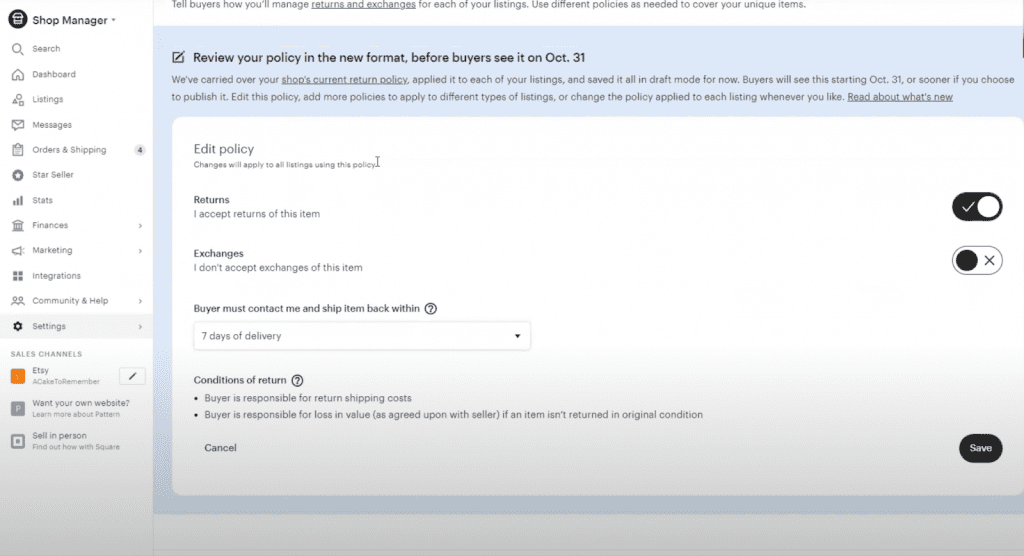
- Select the time frame that you’ll accept returns and exchanges for that item from the dropdown menu.
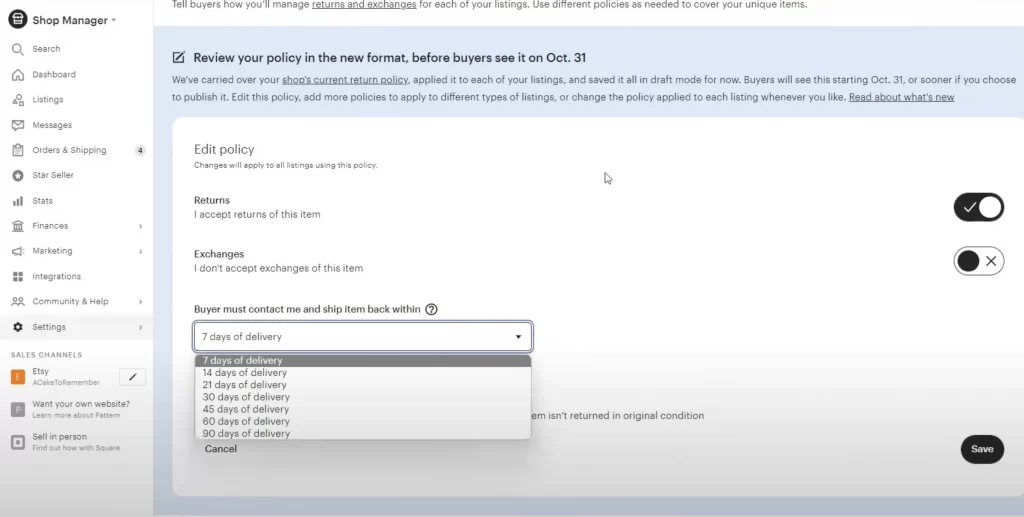
- Select Save and Apply, and then select Publish.
If you’ve created at least one policy in the past, a suggestion to use the policy you’ve set the most on your active listings will be shown. You can also create and/or apply policies to multiple listings at once in Listings Manager.
One additional thing to keep in mind is that EU regulations give buyers the right to cancel or return their orders within 14 days of delivery. If you set your return policy to less than 14 days, a banner reminding you of the EU right of withdrawal will appear on your Returns and Exchanges policy page.
3. How to change the return policy on Etsy?
In case you need to make changes to your Etsy return policy for a particular listing, you can follow the below steps:
- Go to your Shop Manager and select Listings.
- Choose the listing for which you want to modify the return policy.
- Navigate to Returns and Exchanges and click the Change Policy button.
- Select from one of your existing policies, or choose the Create Policy button to create a new policy instead.
- If you want to apply the same policy to multiple listings at once, go to your Listings Manager and select the listings you want to modify.
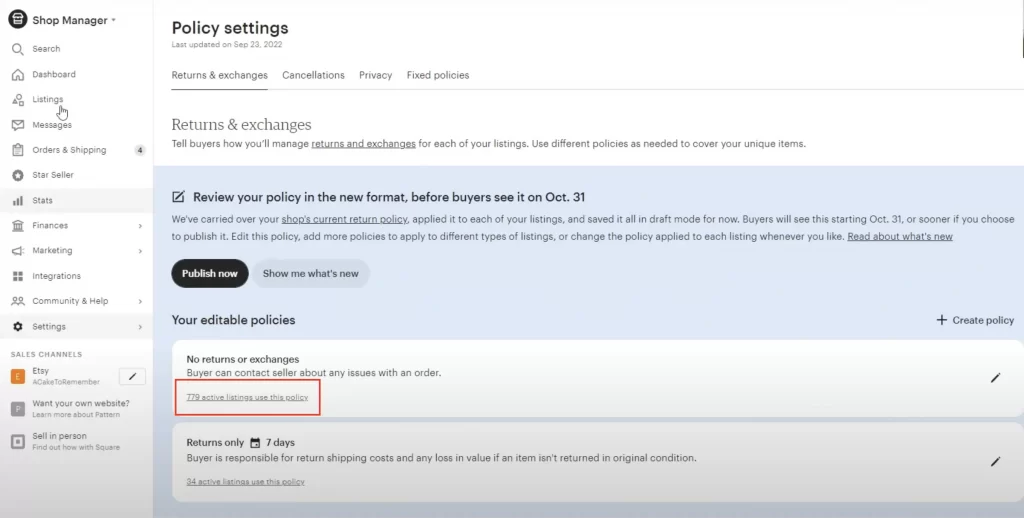
- Click Editing options, then Change return & exchange policies.
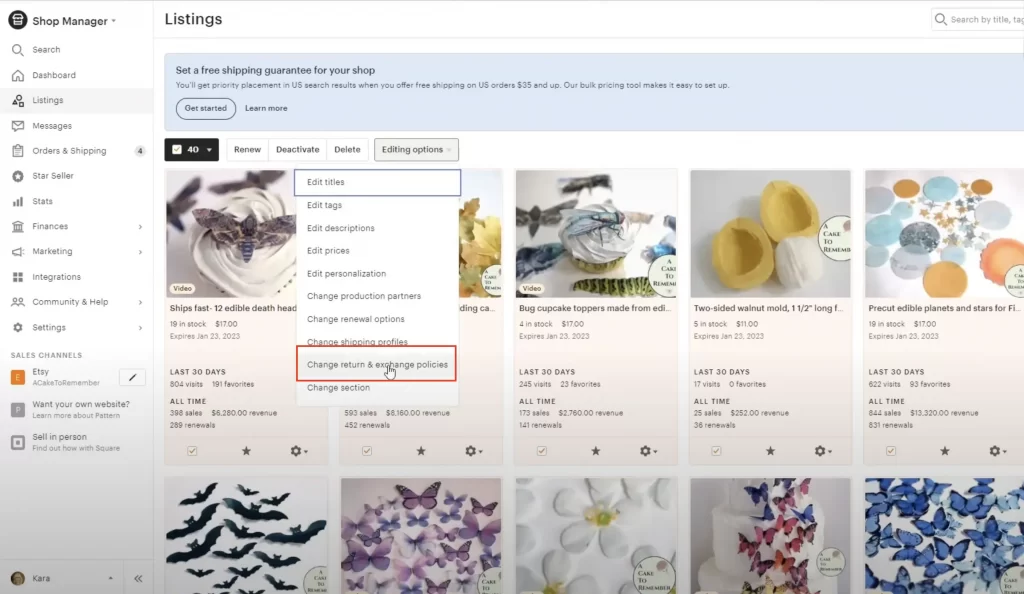
- Apply an existing policy or create a new one.

By following these simple steps, you can easily change the return policy on your Etsy listings as needed.
What to Consider Before Setting Etsy Return Policy?
While it may seem straightforward to establish your Etsy return policy, there are a few more crucial aspects to think about beforehand, such as cancellations and shipping problems. So, what’s in there for you?
Cancellations
Before setting up your Etsy return policy, it’s important to consider the issue of cancellations. You’ll want to decide whether or not you accept cancellations, and if so, under what circumstances and within what time frame.
Additionally, you may need to consider whether custom orders have different cancellation policies. To help you get started, we’ve included a sample Etsy cancellation policy template that you can customize to fit your store’s needs.
“We accept cancellations as long as the request is made before the item is shipped. If you wish to cancel an order after it has been shipped, please contact us to arrange a return. Please note that custom orders cannot be canceled once production has begun. Thank you for your understanding.”
Shipping issues
Etsy’s standard policy is that the customer pays for return shipping unless there is something wrong with the item or if it’s the seller’s fault. While some sellers choose to pay for return shipping themselves, it’s not required unless there are laws mandating it. It’s important to clearly spell out your policies on return shipping costs in your shop policies to avoid any confusion or disputes with customers.
Keep in mind that while buyers may expect free returns, you’re not obligated to cover shipping costs for returns that are simply due to buyer’s remorse. Being transparent about your Etsy return policy upfront can help protect you and ensure a smooth transaction process for both you and your customers.
Etsy Return Policy: FAQs
- Does Etsy have a return policy?
Yes, as an Etsy seller, you can set up your own Etsy return policy for your shop. Etsy provides guidance and templates for creating a policy, but it’s up to the individual seller to decide on the specific terms and conditions.
You can decide whether or not to accept returns, who pays for return shipping, and under what circumstances a return will be accepted. It’s important to have a clear and detailed policy in place to avoid any misunderstandings with buyers.
- Does Etsy provide return labels?
No, Etsy does not provide return labels. As a seller, it is your responsibility to provide your own return shipping labels if you offer returns or exchanges. You may choose to include a return label in the original shipment, but it is not required by Etsy.
- Who pays return shipping on Etsy?
According to Etsy’s standard policy, the customer is responsible for paying for return shipping. However, if the return is due to an issue with the item or seller error, the seller may need to cover the cost of return shipping.
Conclusion
Setting up a clear and comprehensive Etsy return policy is a crucial part of running a successful Etsy shop. By taking the time to consider cancellations, shipping issues, and return shipping costs, you can ensure that you’re providing a positive experience for your customers while also protecting your business. Remember, Etsy provides a framework for your return policy, but it’s up to you to tailor it to your specific needs.
If you have any further questions or need additional guidance, be sure to check out our blog. You can also join our community to connect with other sellers and share tips and advice. Don’t hesitate to take advantage of these resources to help your Etsy shop thrive!

